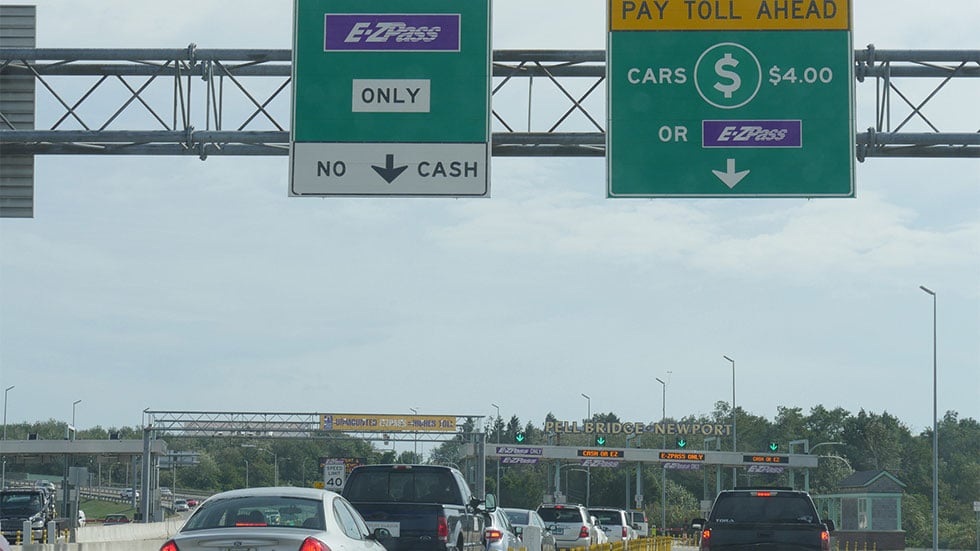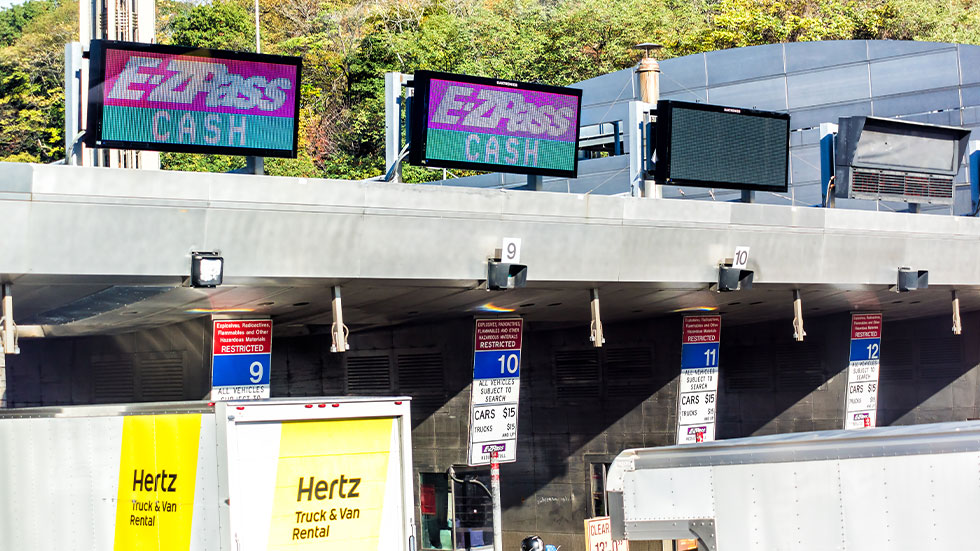Avoid Costly Mistakes When Paying Tolls in a Rental Car
4 ways to steer clear of ‘gotcha’ rental car toll charges, plus how tolls work with rental cars from Avis, Hertz, Enterprise and Sixt


You meticulously planned your vacation budget. You found a great deal on a rental car, declining the insurance because your travel rewards credit card offers primary coverage. You found a gas station to refill the vehicle before returning it to avoid surcharges. And you returned the car without incurring any damages.
You think this chapter of your travels is over until you see—surprise!—a new charge for road tolls from the rental car company on your credit card statement a month later. The unwelcome surprise of rental car toll charges is all too common, which makes knowing the rental car company's policy relating to tolls and your options for making toll payments before you hit the road that much more essential.
Here’s how tolls work with rental cars from four of the biggest rental car companies—and what you can do to avoid paying more than you have to.

How tolls work
Most modern rental cars are equipped with a toll transponder affixed to the top center of the windshield. This device allows drivers to pass through E-ZPass or similarly branded cashless toll lanes, with the rental car company accepting the toll fees on your behalf.
It could take weeks or longer for toll road operators to notify the rental car company of the tolls you racked up with your rental car and for the rental car company to turn around and bill you for those tolls. So, if you opt into a toll billing program when booking your rental, expect the rental car company to pass along those toll charges to you in the form of a bill that you could receive weeks after your trip ends.
Each rental car company has its own policies, so look into those policies before you sign on the dotted line. Here’s how four of the major rental car companies handle tolls.
Avis
Avis offers two billing programs for toll roads in the U.S.: Avis e-Toll and Avis e-Toll Unlimited. Avis e-Toll is a direct bill program in which the actual toll costs are passed along to the renter. Avis adds a convenience fee of $6.95 for each day you incur a toll. While the fee is capped at $34.75 per rental month, you will be charged for the tolls at their highest rate, not the discounted rate typically offered to cashless payers. Avis e-Toll is available in the Northeast, from Maine to North Carolina, as well as in California, Colorado, Florida, Oklahoma, Texas, Washington, Puerto Rico and the Chicago area.
Under the Avis e-Toll Unlimited program, you'll pay a daily fee during your rental, regardless of whether you incur any actual toll charges. However, when you do use a toll road, the actual toll costs will not be directly passed on to you. The convenience fee for this program may vary by rental location and tolling region.

Hertz
Hertz also offers an unlimited program called Hertz PlatePass All-Inclusive Tolling. It operates like Avis' unlimited program, with a daily fee of around $18.99. If you don't opt into Hertz PlatePass but use a toll road, you'll be charged a $9.99 daily convenience fee, and the undiscounted toll charge will be passed on to you. PlatePass is available in 25 states but may not be available at all Hertz rental locations.
Enterprise
Enterprise, the world's largest rental car company, handles tolls using a direct bill method plus a convenience fee. The fees for its TollPass Service vary based on the rental state and whether the location is airport-based. (Check out the TollPass Coverage Map to ensure it applies to where you’ll be traveling.) Most daily fees range from $3.95 to $4.95 and are capped at $30 per rental period. Note that renters in Chicago, however, will pay more. Airport renters and those at select downtown Chicago locations can be charged up to $11.99 daily. In contrast, most non-airport locations in Chicago charge $10.99 daily.
Sixt
A German rental car company, Sixt has been making major inroads in the rental car market here in the U.S. Sixt’s prepaid toll program, called Express Tolls Unlimited, also offers an unlimited toll plan for $12.99 per day. Like its competitors, Sixt adds this fee for each day of your rental regardless of toll activity. Drive without this package, and you’ll pay actual toll costs plus an administrative fee of $9.99 per usage day, up to a maximum amount of $90 per rental agreement.
Easy ways to save on tolls
Now that you know how tolls work with rental cars, here’s how to save money when using toll roads when driving a rental.
1. BYOT: Bring Your Own Transponder
If you already have a transponder for your car at home, can you bring it with you and use it on your rental car? Yes, you can.
Consider packing your transponder to avoid paying daily convenience fees on top of the toll prices and to access discounted cashless toll prices. Just take it out of your personal car and affix it to the rental car near the rearview mirror on the inside of the front windshield, below any tinting.
Additionally, ensure that the rental car's transponder is covered, usually by a sliding cover, so that the toll booth reads your personal transponder, not the rental car’s existing device.
You'll also need to go to the website where you manage your transponder and register the rental car details. According to Ohio's E-ZPass rules, for example, "all vehicles should be added to your account while in use to avoid any violations." Be sure to remove rental vehicles from your account when your trip ends, too, because you are responsible for tolls until you delete the car from your profile.
If you’d like to obtain a personal transponder before your trip, you can pick one up in person at select locations or order one online from a participating state. Also, check to make sure that your transponder will work in those states where you’ll be traveling. E-ZPass, for example, is interoperable on a trip from Maine to Florida, considered E-ZPass states.
2. Pay in Cash
You can also use cash to avoid rental car toll charges, but with many states modernizing their systems, not all toll booths offer a cash option. Research the route you plan to take to see what payment options are accepted.
If you’re self-paying, ensure that the rental car's transponder is covered.
3. Calculate the Unlimited Toll Option
If you plan to drive extensively on toll roads with your rental car, calculate the tolls you will incur ahead of time. Google Maps is a great resource when planning your trip as the software identifies which part of your journey is on a toll road and gives you an estimated cost.
Add up the costs Google calculated, and compare them to the car rental company's unlimited toll option. Remember, you'll pay the unlimited toll fee every day of your rental, even if you don't use toll roads on particular days.
You may save money on short rental periods and interstate, one-way rentals by opting into the unlimited toll program offered by your rental car company. For example, Google estimates a one-way drive from Cleveland to Chicago will cost $31.95 in tolls. This would make an unlimited program a great deal, but only if you're renting just for the one-day drive. The unlimited program will cost you more if you plan to keep the car longer.
You can use the toll calculator on some state websites as an alternative to Google. This will be particularly useful if you drive a nontraditional vehicle that is subject to higher toll rates. For example, Ohio's Fare Calculator will quote you the cash and cashless fare prices determined by vehicle class and your entrance and exit locations.
4. Avoid Toll Roads
While easier in some states than others, you can always set navigation apps to avoid toll roads when providing directions. Considering that time can be money, also compare the time that an alternative route would take, as it may be longer or on a more congested roadway, which could significantly increase your drive time and fuel costs.
The key is to plan for your rental car toll charges to help you save money, avoid headaches and prevent any gotcha toll bills from arriving weeks after your trip ends.
Prices noted in this article were accurate at the time of original publication.

